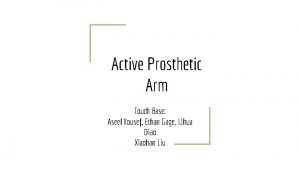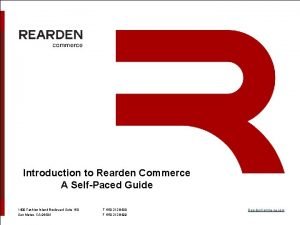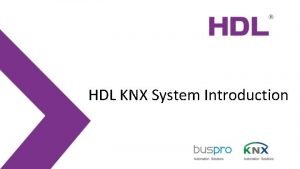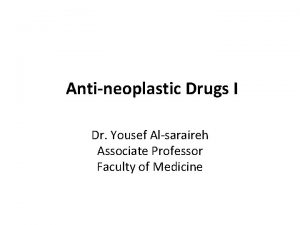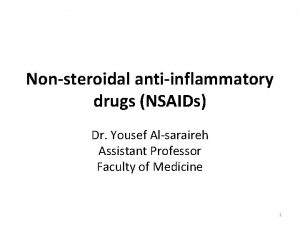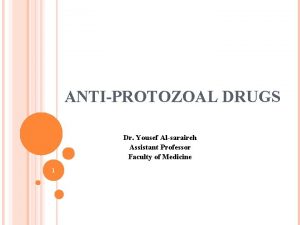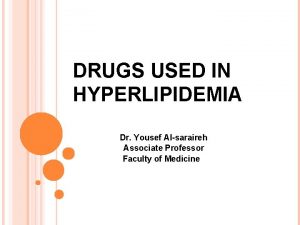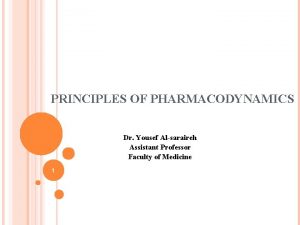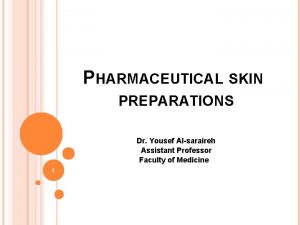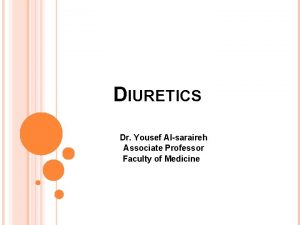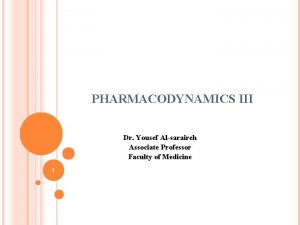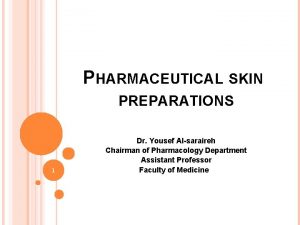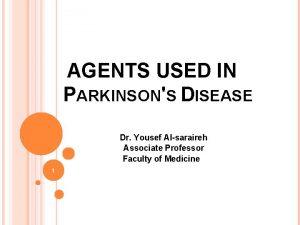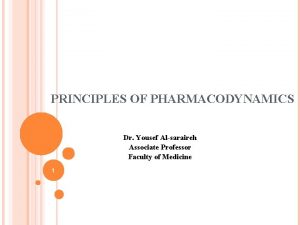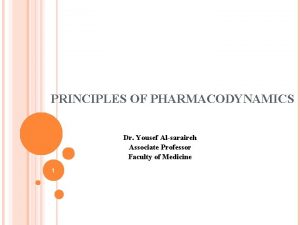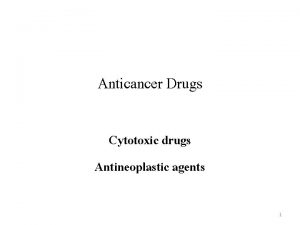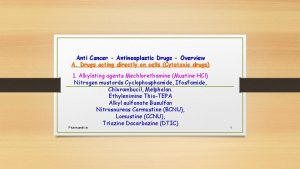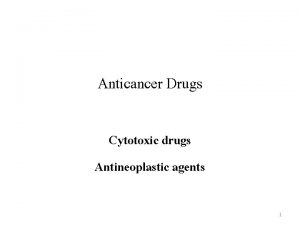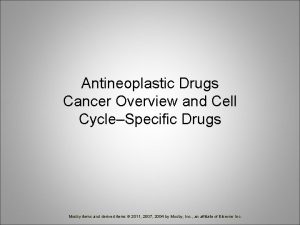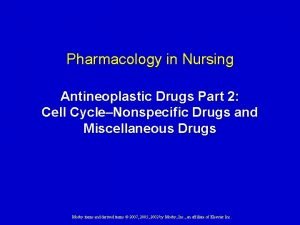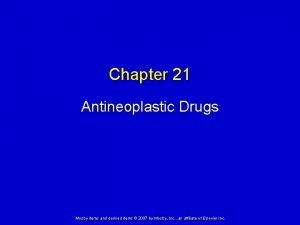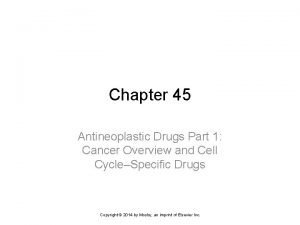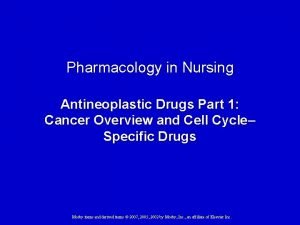Introduction to Antineoplastic Drugs Dr Yousef Alsaraireh Assistant























- Slides: 23

Introduction to Anti-neoplastic Drugs Dr. Yousef Al-saraireh Assistant Professor Faculty of Medicine

Cancer Ø Cancer is an abnormal and uncontrolled growth of cells caused by disruption in the normal controlling mechanisms that govern the balance between cell division, cell death and cell differentiation Ø Tumours can be either: 1. Benign: Non-cancerous, rarely dangerous and grow locally OR 2. Malignant: life-threatening and have the potential to invade locally, spread regionally and metastasize to distant sites in the body

The hallmarks of cancer

1. Self-sufficiency in growth signals: A. Alteration of extracellular growth signals: PDGF in glioblastoma B. Alteration of transcellular transducers of those signals: EGF-R/erb. B) is overexpressed in stomach, brain, and breast tumors C. Alteration of intracellular circuits that translate signals into action: N-myc gene in neuroblastoma 2. Insensitivity to growth-inhibitory signals: lose of TGF-b responsiveness 3. Evading of apoptosis: lose of p 53 responsiveness 4. limitless replicative potential: Upregulation of telomerase enzyme 5. Neoangiogenesis: Overexpression of VEGF and VEGF receptors 6. Tissue invasion and metastasis: Overexpression of cell surface molecules that reduce cell-cell and cell-ECM interactions

Therapeutic methods to treat Cancer 1. Surgery Ø It provides a means for diagnosis, accurate staging of disease and treatment by complete tumour resection 2. Radiotherapy Ø Radiation therapy uses intense ionising radiation to kill cells and is a localised treatment targeted directly to the site of a tumour thereby avoiding damage to other tissues and minimising sideeffects

3. Chemotherapy Ø It is defined as’ the treatment of a disease by a chemical substance’ and is a systemic treatment which aims to inhibit tumour growth and/or induce cell death. Ø Chemotherapy comprises of cytotoxic drugs that target DNA, RNA and protein in order to disrupt the cell cycle of rapidly dividing cells. Ø They attack metabolic sites essential to cell replication e. g. purines & pyrimidines synthesis that are building blocks for DNA & RNA synthesis Ø Anticancer drugs affect all proliferating cells both normal & abnormal cells

Purposes of Anti-neoplastics 1. Primary treatment: Cytotoxic drugs is the primary curative modality for a few diseases, including leukemias, lymphomas, choriocarcinomas, and testicular cancer. 2. Palliative: Cytotoxic drugs is used to relieve symptoms and improve the quality of life in patients with advance stages of cancer. 3. Adjuvant: Use of Cytotoxic drugs to eradicate micrometastatic disease following localized modalities such as surgery or radiation or both. 4. Neoadjuvant: Use of cytotoxic drugs prior to surgery in an attempt to shrink the tumour


Tumor susceptibility & growth cycle Ø Both normal & tumor cells go through growth cycles but they differ in number of cells in each stage Ø Tumours with a high percentage of S-phase cells are aggressively growing Ø Most normal cells exist in the G 0 phase, and most cancer cells are not sensitive to the effects of chemotherapy when in this stage.

Ø Tumour susceptibility to chemotherapeutic agents depends on the fraction of tumour cells that are in replicative cycle (Growth fraction) Ø Rapidly dividing cells are more sensitive to chemotherapeutic agents than slowly proliferating cells Ø On this basis, Chemotherapeutic agents are classified as follows:

1. Cell-cycle specific (CCS) drugs : Ø These act on cycling cells, and can produce their effect more on or selectively on particular phases of cell cycle. Ø Examples: A. Anti-metabolites : inhibit DNA synthesis in (S) phase of cell cycle ; B. Vinca alkaloids: inhibit mitosis phase (M) of cell cycle in the metaphase stage

2. Cell-cycle non specific (CCNS) drugs : Ø Are those with significant activity in multiple phases of cell cycle Ø These destroy cells whether resting or dividing, but are more effective on rapidly dividing cells Ø Examples are: Alkylating agents, cisplatin, nitrosoureas

COMBINATION CHEMOTHERAPY Ø Cytotoxic agents with different toxicities, different molecular sites & mechanisms of action are usually combined at full doses Ø Advantages : 1. Provide maximal cell killing within range of tolerated toxicity, because of additive and/or potentiated cytotoxic effect 2. Are effective against broader range of cell lines 3. May delay or prevent development of resistant cell lines

Strategies of combination chemotherapy a. Pulse therapy : Involves intermittent cycles employing usually high doses of drugs are given for 3 -4 weeks followed by rest non-drug period to allow hematologic and immunologic recovery b. Recruitment : CCNS drugs are given first to get significant cell-kill ; this results in recruiting the remaining resting viable cells into cell cycle thus, CCS drugs are used then to get maximal cell-kill of recruited cells. c. Synchrony : e. g. Vinca alkaloids are used to stop cell cycle at the mitosis phase , and are followed by S-phase specific drugs to get maximal cell-kill

Ø An example of combination chemotherapy is the common regimen called POMP Ø POMP consists of Prednisone, Oncovin (vincristine), Methotrexate & Purinethol (mercaptopurine) Ø POMP regimen is used for treatment of acute lymphocytic leukemia (ALL)

Problems associated with chemotherapy 1. Resistance to chemotherapy: Ø It can be either: A. Primary: inherent drug resistance; absence of response on the first exposure e. g. Melanoma B. Acquired: develops after their use due to inadequate doses or duration of treatment. Ø Resistance can be specific for a single drug or to many drugs (Multi-drug resistance MDR).

Mechanisms of resistance include the following: A. Increased DNA repair: alkylating drugs and cisplatin B. Decreased activation of pro-drugs: Decrease in activity of tumor cell enzymes needed to convert these drugs to cytotoxic metabolite e. g antimetabolites C. Inactivation of effective drugs: Increased activity of enzymes capable of inactivating drugs e. g. antimetabolites D. Changes in target enzyme: Decreased affinity or increased production of target enzymes for cytotoxic drugs e. g. DHFR E. Formation of trapping agents: increased formation of trapping agents such as glutathione which interact with drug e. g. anthracyclines, bleomycin, and cisplatin F. Decreased drug accumulation inside cancer cells : this usually causes multi-drug resistance and is due to increased formation of membrane P-170 glycoprotein that leads to increased efflux of many cytotoxic drugs out of cancer cells

2. Toxicity of chemotherapy: 1. Acute effects: nausea and vomiting 2. Subacute or Delayed effects : A. Bone marrow depression : due to damage to stem cells or progenitors. This is a very important limiting factor in use of these drugs. It may result in : 1. Leucopenia 2. Thrombocytopenia : which may cause bleeding 3. Anemia 4. Pancytopenia

B. Immunosuppression : which also increases incidence of infections; it is due to damage to both B-lymphocytes ( which mediate immunity by differentiating into plasma cells that produce anti-bodies) and T-lymphocytes ( which mediate cell-mediated immune reactions ) C. GIT damage: esp. to rapidly dividing epithelium causing mucositis that is seen as stomatitis, vomiting or diarrhea D. Skin: esp. to hair follicles causing alopecia (usually temporary; hair re-grows again within 1 year ) E. Damage to gonads : This may cause sterility ( esp. important in children), or mutations. Use in pregnancy is contra-indicated since they may cause abortion or teratogenesis

F. Delayed wound healing G. Hyperuricemia : it is due to destruction of large number of tumour cells in sensitive cancers e. g. myeloma that leads to release of large amounts of nucleoproteins which , after their metabolism, lead to increased uric acid formation from purines in liver. H. Oncogenic effect : Second cancers (e. g. leukemia ) have been reported few years after use of these drugs esp. alkylating agents and some anti-metabolites

I. Specific toxicity: May occur with many drugs. Examples include: Hepatic toxicity with 6 -mercaptopurine, Neurotoxicity with vincristine. Hemorrhagic cysteitis with cyclophosphamide , Cardiac toxicity with the Anthracyclines , Lung toxicity with bleomycin, and Renal toxicity with cisplatin.

Contra-indications a. Very advanced disease in debilitated patients b. Active infection c. Pre-existing bone marrow depression d. Preganancy

Anti-neoplastic Drugs 1. Antimetabolites 2. Antibiotics 3. Alkylating agents 4. Microtubule inhibitors 5. Topoisomerase inhibitors 6. Steroid hormones & their antagonists 7. Monoclonal antibodies 8. Others
 Jessica yousef
Jessica yousef Aseel yousef
Aseel yousef Leena yousef
Leena yousef Sara yousef
Sara yousef Yousef javadi
Yousef javadi Sara yousef
Sara yousef Sara yousef
Sara yousef Cpit 110
Cpit 110 The sign makers assistant
The sign makers assistant Workkeys applied mathematics level 4 answers
Workkeys applied mathematics level 4 answers The adaa was formed in 1924 by:
The adaa was formed in 1924 by: Fglair setup
Fglair setup Medical assistant program rop
Medical assistant program rop Promotion from assistant to associate professor
Promotion from assistant to associate professor Mia irwan
Mia irwan Cisco configuration assistant (cca)
Cisco configuration assistant (cca) Kpu health care assistant
Kpu health care assistant Virtually there e ticket receipt
Virtually there e ticket receipt Cooperative interview questions
Cooperative interview questions Ibm support assistant workbench
Ibm support assistant workbench Vms4200
Vms4200 Knx presentation
Knx presentation Fok ping kwan
Fok ping kwan Assistant scorer
Assistant scorer

